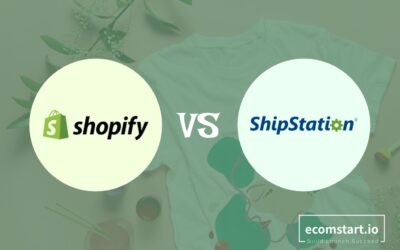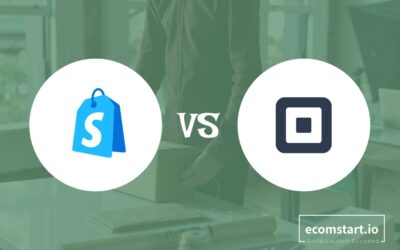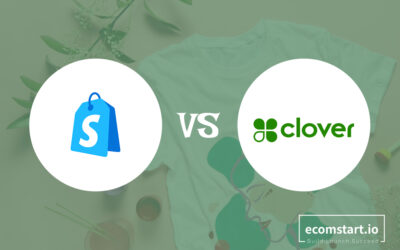Shopify vs Webflow eCommerce: Which is The Best for Your Online Venture?
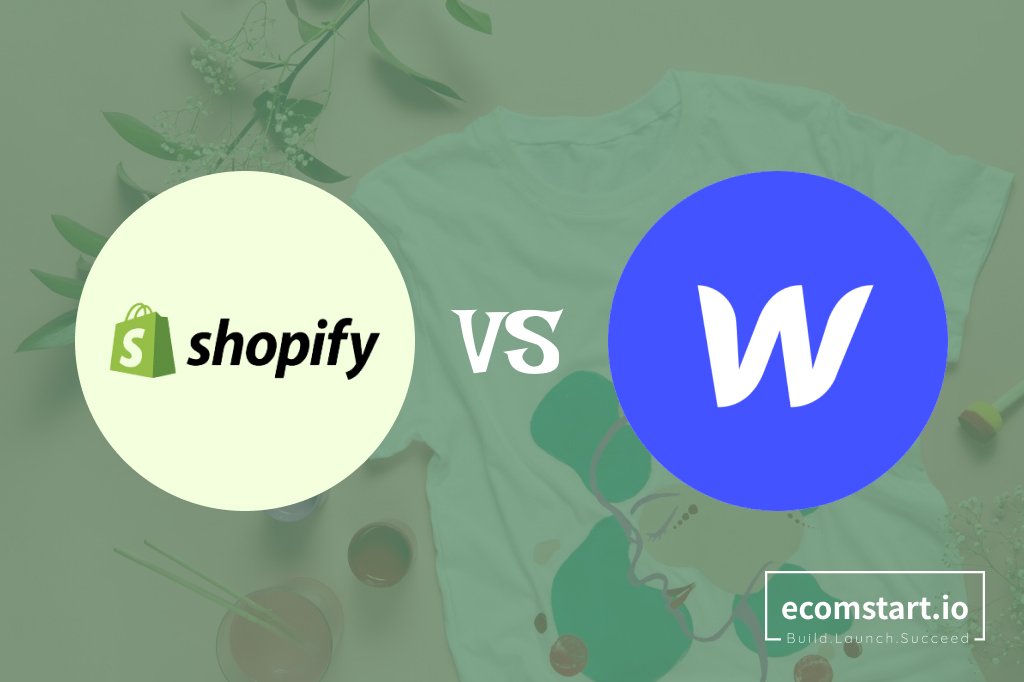
Selecting the best platform to launch your eCommerce business is essential if you’re new to online selling and want a good start.
Shopify vs Webflow eCommerce are two of so many different platforms on the market that provide everything you need to launch a professional-looking online store.
They offer an all-in-one approach to online store creation, management, and promotion. This means you can handle your entire eCommerce website from the convenience of one dashboard.
Not enough time for comparisons by yourself? Not to worry! You can find out which eCommerce builder is perfect for you by reading our post!
Contents
1. Shopify vs Webflow eCommerce: Overview & Key Differences
One of the most widely used eCommerce store builders is Shopify. The platform’s goal is to assist you in opening an online store as soon as possible and selling your goods there.
It serves the purpose of the development of perfect online stores. As a result, it provides many outstanding features, such as marketing, POS, analytics, and other tools for managing your online business efficiently.
Webflow is a no-code development tool for creating websites, blogs, and online storefronts. This platform provides customers with a powerful content management system, visual website builder, and online shop management panel.
As one of the most well-liked all-in-one eCommerce systems, Webflow enables customers to create websites from the start using a visual interface without knowing how to write bespoke code.
| Shopify | Webflow | The Verdict | |
|---|---|---|---|
| Pricing | Monthly subscriptions start at $29 (When billed yearly) + extra fees | Monthly subscriptions start at $29 (When billed yearly) + extra fees | Shopify won |
| Design & customization | Shopify has several attractive templates; however, you’ll only have ten free themes. Otherwise, you’ll need to pay for a more advanced template. | Webflow provides beautiful, free templates to choose from. Its editor also provides a high level of customization, so you can tailor your site to your needs. | Webflow won |
| Ease of Use | Shopify is simple to use. Its features are all user-friendly. | Built for designers, Webflow isn’t the easiest builder to navigate. It doesn’t use drag and drop, and its terminology will be unfamiliar to beginners | Shopify won |
| eCommerce features | Shopify’s eCommerce features are tailored to the particular needs of small and medium-sized stores. It has everything you need to operate your business smoothly. | Webflow offers fewer eCommerce features than Shopify, making it hard to grow your store | Shopify won |
| Marketing tools | Shopify comes with good SEO tools, the ability to add a blog, and in-depth analytics tools | Webflow has excellent blogging features but other tools like SEO features and fundamental analytics are quite basic | Shopify won |
| Apps & integrations | Shopify’s expansive app store is perfect for growing your website. | Webflow has limited integrations. | Shopify won |
| Scalability | Lots of plugins and different pricing packages to fit your growing needs | It is hard to scale your business later | Shopify won |
2. Webflow eCommerce vs Shopify: A Deep Dive Comparison
2.1. Pricing
2.1.1. Shopify Pricing

Shopify offers three main subscription plans starting at $29 and up to $299 if you pay yearly. Shopify offers a 3-day free trial and 1$ for the first month, but no free plan is available. Setting up your business won’t happen until you subscribe to a premium subscription.
Whatever plan you choose, Shopify provides more than 100 different payment channels. There are no transaction costs if you use Shopify Payments, the company’s payment gateway. If not, each transaction will cost you between 0.5 and 2%, with the lowest plan having the highest costs.
2.1.2. Webflow Pricing

Webflow’s pricing structures appear confusing at first sight. They can be divided into two groups: Site Plans and Workspace Plans.
We will investigate Webflow’s eCommerce plans since we compare it to Shopify.
Three price categories are available from Webflow: Standard, Plus, and Advanced. A 2% transaction charge is added to the $29/month (yearly) Standard plan. A configurable shopping cart, a shopping gateway, and the ability to list 500 goods are all included in the plan. All other CMS plan features are also included.
Upgrade to the Plus plan to eliminate the 2% transaction fees. The monthly cost of the plan is $74, payable annually. Additionally, you may utilize all of the features of the business plan, and it supports 5,000 products.
The last and most costly Advanced plan has a monthly starting price of $212 (paid annually). Additionally, you receive all business plan features, no transaction costs, and space for 15,000 e-commerce goods to be listed.
The Verdict: When comparing Shopify vs Webflow cost, it’s evident that both platforms offer comparable pricing plans. However, Shopify stands out as the more affordable option. Though more costly than Webflow, its mid-tier and advanced plans have a far larger feature set.
2.2. Design & customization
Shopify offers free and premium themes to suit various budgets. It is important to note that the premium options have a more prominent feature set, which is essential for companies looking to expand.
With Shopify’s What You See Is What You Get (WYSIWYG) feature, you may alter your theme’s layout, colors, fonts, and pictures by dragging and dropping components around in the left toolbar.
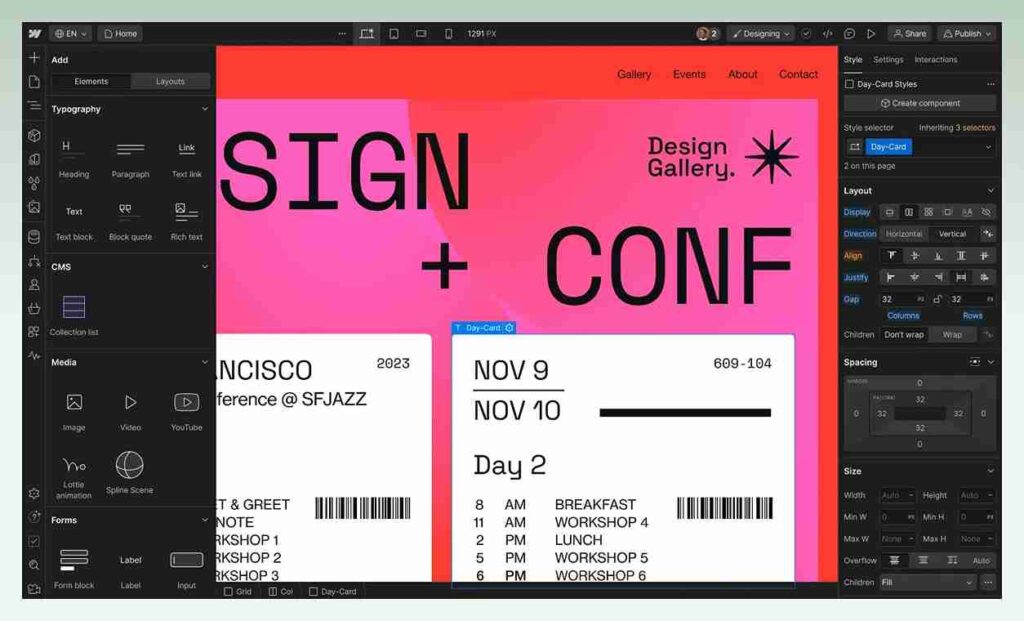
More than 2,000 templates are available on Webflow, with a significant portion devoted to eCommerce. They are polished and well-thought-out designs.
Thanks to the increased customizability of Webflow’s editor, you can easily bend the themes every which way with the visual website editor.
| Shopify | Webflow |
|---|---|
| – Free themes or premium ones or choose a Shopify theme created by third-party authors – Theme-setting editor to change the colors, fonts, images, and logos – Sorting/ Filtering of search results – Bulk image upload – Bulk product import/export | – Over 2,000 free and premium templates – Visual editor to change theme elements – Interaction features to build animations – The customizability of every single element on the page – Branded checkout page – Customizable shopping cart and emails – Fully custom product pages – Creating and editing global color swatches |
The Verdict: Webflow’s exquisitely designed and feature-rich themes with easier customization tools make it stand out against Shopify.
2.3. Ease of use
Establishing a store is simple and quick with Shopify. It offers a helpful onboarding checklist to assist you in completing all of the essential duties involved in launching an online business. Additionally, it’s a terrific method to navigate the dashboard.
In contrast, Webflow is more complex. Given that it’s frequently compared to a hybrid of a content management system (CMS) and a website builder, web designers and developers are more likely to use its feature-rich editor and dashboard.
The Verdict: Compared to Webflow, Shopify is a more straightforward platform thanks to its easy-to-use editor and onboarding checklists.
💡 Learn more: Shopify vs eBay: Which is Better for Starting an Online Store?
2.4. eCommerce features
eCommerce features must be among your top considerations when launching an online store. Both Shopify and Webflow offer several selling tools, but we’ll go into more detail about each of them below so you can make sure they work for you. Keep reading to learn more about Webflow vs Shopify for eCommerce.
2.4.1. Inventory management
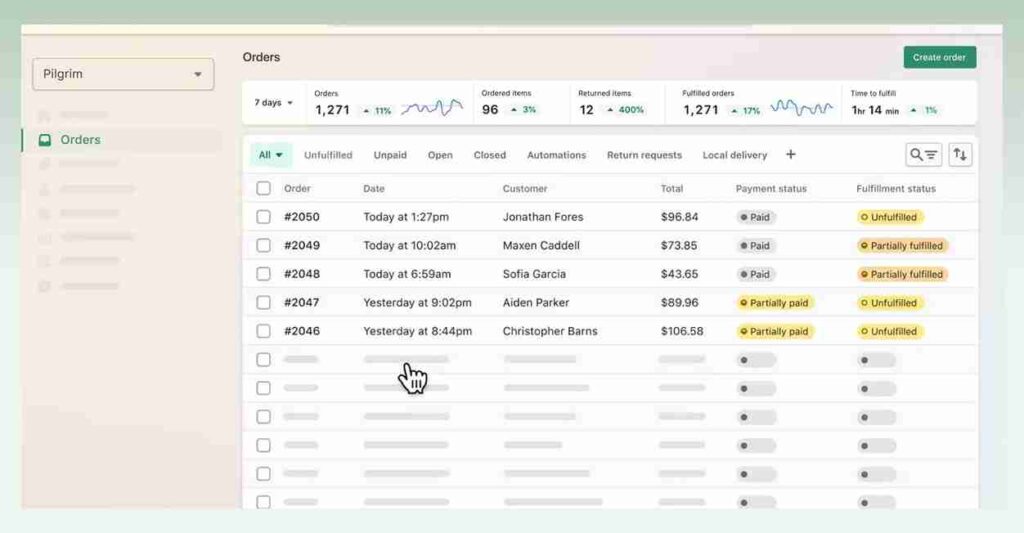
Shopify has the most robust inventory management among all the eCommerce builders we examined. It works effectively for big-box retailers needing a complex system to handle more inventory.
You can easily manage your inventory from Shopify’s dashboard. You can conceal out-of-stock goods, track and manage inventory, set various pricing for your versions, and move inventory across locations.
Webflow is more limited. Your price strategy determines the quantity of goods you can sell. Furthermore, you will also have to deal with a restricted sales volume.
You can maintain customer accounts, track orders, and view order histories from Webflow’s dashboard. Webflow also offers basic functions for inventory management.
| Shopify | Odoo |
|---|---|
| – Unlimited products, both physical and digital – Support a large number of product variants – Create product categories to organize your product catalog better – Bulk product importIntegrations with plenty of dropshipping apps – Create and track customer profiles – Manage your store while you’re on the run using Shopify’s smartphone app – ABC inventory analysis | – The number of products you can sell depends on your pricing plan – Limited sales volume – Inventory tracking – Low quantity and out-of-stock warnings – The ability to add variants |
The Verdict: Webflow is a respectable competitor, but it isn’t quite as extensive as Shopify’s eCommerce feature set.
2.4.3. Shipping
The shipping features offered by Shopify are cutting-edge. To put it simply, Shopify goes a long way toward streamlining one of the trickiest aspects of the selling process.
Shopify automatically determines your shipping costs depending on your location and your shipment’s destination. Additionally, you may provide free delivery after a certain price threshold and purchase label printing.
On Webflow, this functionality is much less developed. You can set up manual shipping costs here, but you’ll need to link your business with a third-party app if you want typical shipping features like Shopify has.
| Shopify | Webflow |
|---|---|
| – Discounted rates – Partnerships with big names such as USPS, DHL Express, and UPS – Buy and print your shipping labels – Label printing – Calculate your shipping costs, set your shipping locations, and amend your prices based on weight or destination | – Manual shipping rates – Integrate your store with a third-party app like Shippo. |
The Verdict: Shopify wins this time. Regarding shipping capabilities, it is more advanced and provides greater automation.
2.4.4. Point of sale
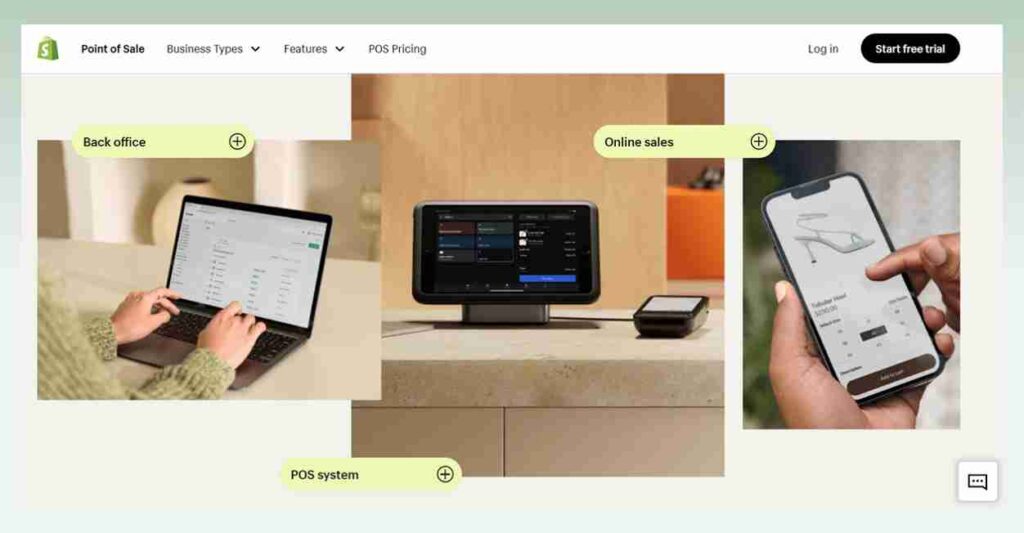
Having a POS to sync your offline and online sales is a significant advantage because many brick-and-mortar businesses also have online outlets. No matter where you sell, Shopify’s patented POS system will maintain inventory synchronization, allowing you always to be aware of your stock levels.
Regretfully, Webflow does not provide an integration or point of sale at this time.
The Verdict: Shopify takes the victory. Shopify’s POS system is at your disposal to help you sell online and offline, while Webflow falls short of this.
2.4.5. Payment Methods
Shopify is a well-known eCommerce platform that offers partnerships with over 100 payment channels, including PayPal and Amazon Pay. Additionally, Shopify Payments serves as its native payment gateway.
Third-party payment gateways usually charge a transaction fee, but there won’t be additional costs if you utilize Shopify Payments.
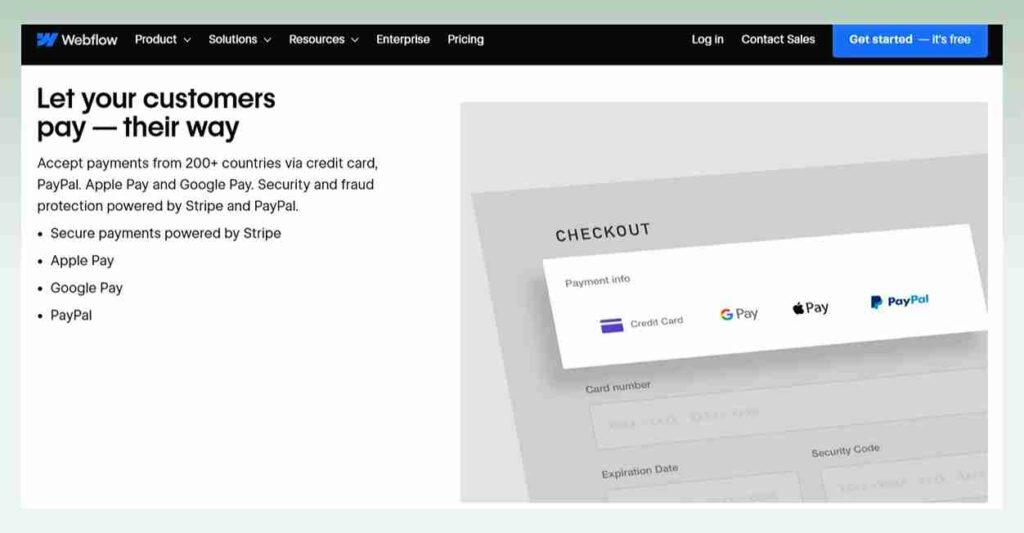
Webflow offers a respectable range of payment channels. All popular credit cards and digital wallets, like Google Pay, Apple Pay, and PayPal, are accepted. In addition, you accept payments from more than 200 nations. Moreover, refunds are managed via these payment channels.
When using a payment gateway on Webflow, you must also pay a transaction charge, just like with Shopify. If you choose the more costly Plus or Advanced plans, you can avoid paying the charge.
The Verdict: Shopify is compatible with over 100 payment gateways and offers its gateway, Shopify Payments. Webflow, on the other hand, supports a much smaller selection of gateways. That’s why Shopify takes the lead here.
2.5. Marketing tools
Selecting a platform and creating an online business are one thing; drawing customers and making a profit is another. That’s why having a solid toolkit of marketing is essential. We’ll examine Webflow’s and Shopify’s performance in this area below.
| Marketing Features | Shopify | Webflow |
|---|---|---|
| Email Marketing | Tools such as Shopify Email are included for composing, sending, and tracking emails right within the platform. | You may start growing your email list and expanding your reach by connecting Webflow to Mailchimp. |
| Social Media Integration | Shopify lets you set up Facebook Pixel or Google Ads to create user-targeted advertisements and sell them on social media. With Shopify, you can produce videos of your items for your social media feeds, use multimedia tools like Video Crockpot, and use Snapchat Ads and Pinterest “Pin It” buttons. | With Webflow, you can integrate your social network feeds and symbols into your website pages and sell on social media. About 13 social media integrations are available on Webflow, such as Twitter Share, EmbedSocial, and EmbedStories. |
| SEO Features | Shopify provides the basic tools along with educational materials about SEO. The main feature it lacks is keyword support, but you can download applications to make up for it. | Webflow has remarkable performance in SEO. It includes the following in addition to keeping all of its code as clean as possible for search engine crawlers: – Meta titles and descriptions – Image alt text – Custom URLs – XML sitemap generation |
| Blogging | You may use Shopify to showcase categories, comments, and an RSS feed and use blog-specific SEO tools. | It should come as no surprise that Webflow is an excellent choice for blogs because it has some CMS DNA. With a few clicks, you can edit the page directly, adding any additional items you like straight into the code. |
| Reporting & Analytics | Shopify includes its own metrics by default. Additionally, you may link Google Analytics to your store. However, Shopify lacks blog-specific metrics. | The few built-in statistics in Webflow don’t display much information beyond your first visitor count. |
The Verdict: While Webflow vs Shopify provides fundamentally comparable marketing services, Shopify goes above and beyond what Webflow offers. This is particularly true regarding email marketing and reporting, where Shopify excels beyond measure.
2.6. App & integrations
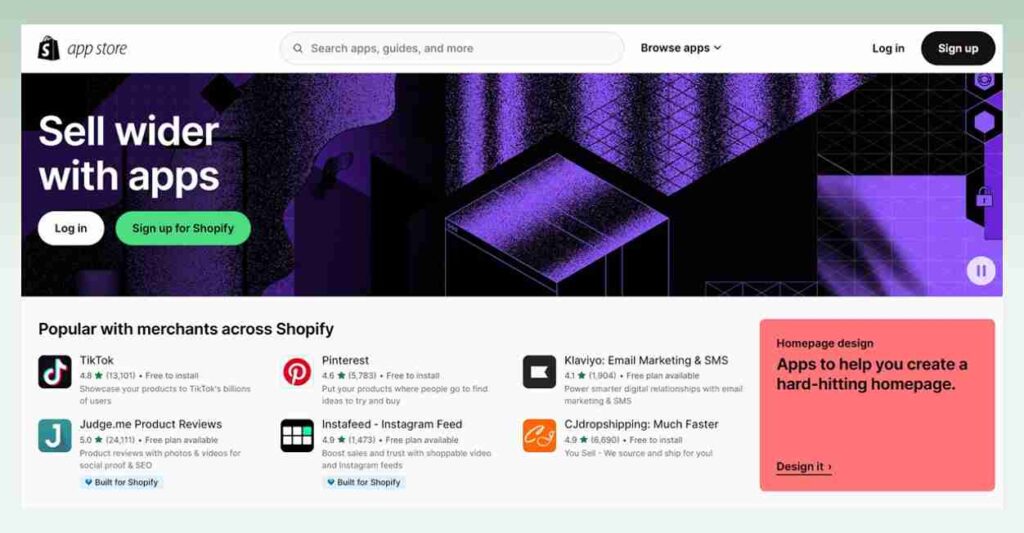
Shopify is the titan of apps. Its app store is among the largest out there, with thousands of tools at your disposal to enhance the operation of your store. Besides, it offers lots of seamless integrations to help you broaden your market to different channels and platforms.
Meanwhile, Webflow does not have an app store at all. This could be the case since its target audience consists of more tech-savvy builders who can directly code their desired features into the store’s underlying code. You may need to use a platform like Zapier if you want to include any third-party functionality.
The Verdict: Shopify is undoubtedly the winner. It offers access to the Shopify App Store, where you can find any apps you need to improve your business. And that doesn’t happen to Webflow.
2.7. Scalability
Shopify is one of the most scalable eCommerce platforms for managing high traffic and sales volumes. The platform may expand without the need for manual improvements.
It is also designed for international online shopping; in addition to localization options, it supports numerous currencies and international payment gateways. It offers the newest features that can support highly demanded online shops.
Webflow was designed for websites and small teams. Although the firm has made enhancements to enable you to store more content assets and add additional content kinds, that just touches the tip of what you want in terms of scalability.
Scalability issues with Webflow make adding and customizing additional rights to expand your company challenging. It isn’t designed to distribute material across several platforms.
The Verdict: The winner is Shopify, as it can grow with your business effectively.
3. Shopify vs Webflow: Who Holds the Winning Hand?
Shopify is the greatest option for certain people, even if it wins the majority of categories in this Webflow vs Shopify comparison.
We advise using Shopify if:
- You own a sizable store or a complex inventory.
- You want a builder that is simple to use and doesn’t require a lot of technical expertise.
- You need lots of space to expand your business.
In contrast, we advise using Webflow if:
- You wish to manage a medium-sized or small business.
- The central component of your company is your blog.
- You own a design company and create websites for customers.
- Your priorities are exquisite designs and unrestricted creativity.
Not a fan of Webflow? No problem! Explore Shopify vs competitors to find more options for building your online store. Compare their pros and cons with those of Shopify to find the ideal fit for your business.
4. Conclusion
This thorough head-to-head comparison of Webflow eCommerce vs Shopify has finally ended. We can tell how potent each tool is when we compare them.
With many features to help your business reach every growth milestone, Shopify is the most fantastic eCommerce platform available today, powering almost 3 million active websites.
Webflow is particularly well-liked by companies that want a distinctive website with personalized services. You can create websites from scratch and edit each component using Webflow.
After reading through our Shopify vs Webflow eCommerce analysis, if you’re still unsure which platform is best for you, eComStart suggests launching with Shopify, the clear winner of this eCommerce platforms comparison.
5. FAQs
Not at all! Once you’ve mastered the front and backend editors, Shopify is straightforward to use, and editing the pages in your store is a breeze.
However, since Webflow is intended for users with some design knowledge, it is a little more complex, but don’t let that deter you. Its five-minute tutorial, which takes you through a thorough tour of the editor’s main features, is among the best that we have found.
Webflow is best for small or medium-sized stores or if you prioritize beautiful designs and creative freedom.
The support centers for Shopify and Webflow are outstanding and provide a wealth of expert advice and tutorials. This is where you should start, and based on our experience, you can typically discover the answer to your issue there!





